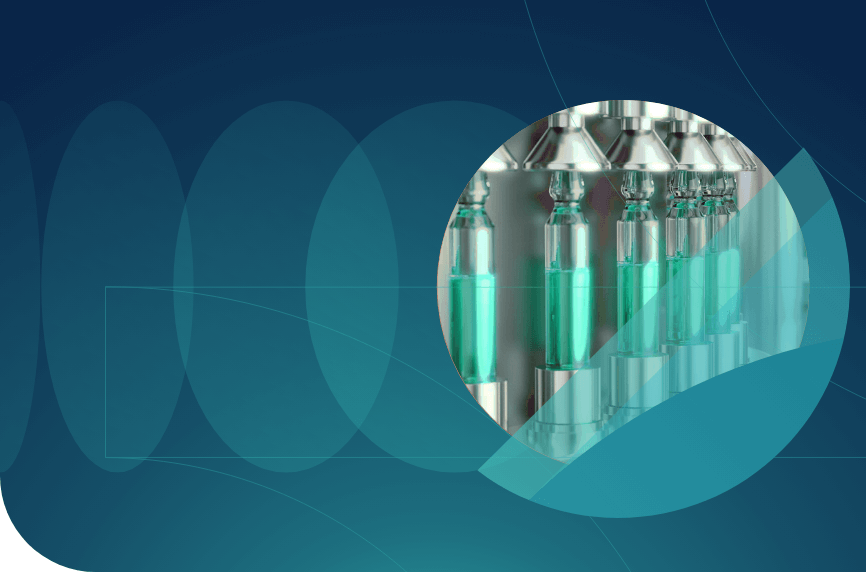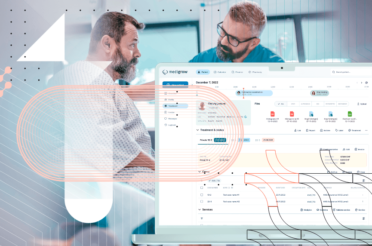Within the life science and pharmaceutical industry, adherence to stringent manufacturing standards is non-negotiable.
Governed by the Good Manufacturing Practice (GMP) guidelines, often considered the holy bible of industry standards, these regulations ensure the utmost quality, safety, and efficacy of products.
However, the complexity and volume of regulatory requirements within GMP can be overwhelming. In response to this challenge, the industry is turning to a transformative solution — the automation of GMP compliance management processes. This shift not only addresses regulatory intricacies but also marks a significant evolution in the pursuit of excellence within pharmaceutical manufacturing.
The development of such software is no easy task, however. That is why we have endeavored to learn more from someone who has practical experience with it – our expert Lead Software Architect Harry Birimirski.
GMP and GAMP in a nutshell
GMP and Good Automated Manufacturing Practices (GAMP) are two terms that seem rather alike but are, in fact, completely different.
On one hand, we have GMP, which is a guideline that facilitates efficient manufacturing practices for any kind of business that handles the manufacturing process. On the other hand, GAMP is again a guideline, but it is meant to pave the way for software that automates GMP.
Despite all of the regulations and different systems in place and a clear picture of what needs to be done, pharmaceutical manufacturers face some challenges during the production management process. An essential part of overcoming these challenges and continually improving operations is, of course, using digital tools for process digitization.
However, in these regulated industries that require a high level of compliance, more than digitization of the process is required. Process validation and automation solutions are also needed to support this shift.
“There is a big difference between healthcare software and the normal one. But to this day there isn’t really a difference in the developers who make the software.”
Harry Birimirski
GMP can deal with many different aspects of the manufacturing process and even beyond it. Creating a system that can keep track of all of these factors can be tricky. And in order to be sure that such a system is safe and secure, there need to be guidelines that make sure of that.
That’s where GAMP comes in. GAMP helps developers better understand the complexity of creating and implementing software that validates the principles of GMP, especially in healthcare products.

Embrace the future of manufacturing compliance
Book a meeting with one of BGO’s experts on pharmaceutical IT solutions to see where we can help you with your business

How does GMP apply to your business?
When it comes to the development of products, especially pharmaceuticals, having an efficient manufacturing process that proves to be consistent in how well it functions is a definite must.
The best way to ensure just that is through strict adherence to good manufacturing practices. Analyzing the final product is not enough when it comes to the safe manufacture of health products or medication. Regulatory bodies in these industries will simply not allow it.
Regulatory requirements that make it a necessity
There are government and international agencies that require adherence to guidelines like GMP when it comes to healthcare products. Having a system that takes care of such requirements can improve the quality of the product and substantially reduce problems with regulatory bodies.
“Being a good developer does not mean that you know all the rules for making such systems and all the requirements. That’s why having someone that does is almost a need.”
Harry Birimirski
Even our expert who has years of experience in the field of creating GMP validated software claims that it is not the job of the developers to know all the guidelines and having a consultant who does can be of great help. GAMP software can be such a consultant. It can keep track of all aspects of development needed for compliance with the laws.
To show exactly how many such laws exist, we asked Harry about some of them:
- FDA (Food and Drug Administration in the U.S.): The FDA is an enforcer of GMP regulations (referred to as cGMP, where the “c” stands for “current”), which require that manufacturers, processors, and packagers of pharmaceutical products take proactive steps to ensure safety, security, and effectiveness. cGMP regulations are meant to guide manufacturers to create products up to quality standards.
- EMA (European Medicines Agency): Just like the FDA, the EMA has its set of GMP standards for pharmaceuticals in the EU. The standards they administer are made to be compatible and synchronized with the ones the FDA has in order to account for companies operating in multiple countries.
- WHO (World Health Organization): The WHO provides GMP guidelines that many different countries around the world adopt. These are especially significant for countries without their own formal regulatory bodies but are manufacturing drugs for domestic use or export.
These are only some of the more important regulatory agencies. GMP automation can be a great assist to not only understand all of the rules they administer but also adhere to them.
Key automation areas
There are many different areas in which GAMP systems can be beneficial for your business. Our expert goes more in-depth about the specific aspects that are enhanced by such software.
One such area is documentation control. Automated systems are able to manage document lifecycles including the creation of a record. They are also able to keep track of reviews and approvals. A GMP principle that has to be followed here is for the secure archiving of documents which Harry tells us is no easy task when developing healthcare manufacturing software.
“We’re not talking about a document or two here. When there are already thousands of records stored and you realize that they are not being handled according to the guidelines there may arise a need to start the whole development process all over again.”
Harry Birimirski
You can make reporting more effective by focusing on these process automation alternatives:
- Report template: Create an appropriate template for the needs of your reports and access them with a single click.
- Auto-generation: If you need some information to be shown weekly, you can set up some reports that will automatically be sent to your team аs you scheduled.
- Dashboard metrics: The best solution for your needs will let you choose the most important metrics that you want to see on a single dashboard at any time. This will allow you to always keep an eye on your priority metrics.
- Exception reporting: Your business – your rules. With exception reporting, you can get notifications when certain conditions or events occur according to your business requirements. You can use these reports in the automation system to optimize manufacturing products.
Furthermore, GMP automation can help manufacturers with audit management. According to our expert, dealing with audits can be one of the most difficult steps in developing such software. Usually, there are internal audits done before the real ones to make sure that everything is compliant with the rules. Regulatory bodies do give you some time to fix errors or non-adherence even if the internal audits have missed something.
Additionally, such systems can assist your business with training management. In this area, the software ensures all employees are trained on the latest procedures and regulatory requirements. An automated process can keep track of training completion and send reminders for re-certification or when new training is needed.
Automating your GMP compliance processes is a critical convenience for your company that will result in long-term measurable results.
Choosing the right software for your business
Automatization of GMP processes starts with choosing the right compliant GMP computerized systems.
When searching for a technology product, you have to ensure that it is flexible enough to modify according to your existing processes and quality standards. Regulated companies have their specifics, and buying and relying on off-the-shelf computer system validation with no option to tailor it to your use cases beyond its defined procedures can be a dangerous move.
Don’t expect to find a solution that will be suitable for your processes forever without any changes. Your business changes, GMP standards change, the industry changes. Sooner or later, you will need to adapt the software to fit the current current good manufacturing practices to maintain compliance and productivity.
The right strategic approach is to identify a trusted IT partner with industry technology expertise who has the needed experience and ready platforms, which can be easily modified to fit your needs. In this way, you eliminate the risk while decreasing the market time.
How to integrate your processes into the solution
Integration of processes is crucial in the international society of industries nowadays. The best solution for automating your GMP management processes will allow you to integrate all existing processes in a commonplace. Implement a single solution for document control, audit management, compliance training management, corrective actions, compliance handling, and audit trails.
Every automation is good, but in many aspects, companies rely on humans to make the final decisions. By now, technologies have not reached the level where they could automate decision-making, but it is possible to standardize process development. Incorporating risk assessment into your business is maybe the best practice for doing it.
This will make it possible to create a risk template for all applications that will allow you to assess high-risk gaps, run a risk-based verification check, and even benchmark suppliers according to risk level.

Learn and innovate with –automation solutions
Let us help you understand more about automating quality assurance processes for your business with good manufacturing practices
Don’t forget reporting.
Once you find the right solution for automating your GMP management processes, you will need to observe everything happening in your business. Here comes centralized reporting which is one of the biggest advantages of this kind of solution.
When dealing with pharmaceutical products like medical devices and prescription drugs, it is in the job descriptions of regulatory bodies to ensure that such products are consistently produced with no serious violations.
It is in BGO Software’s job description to assist in designing and deploying intelligent IT solutions for leading pharmaceutical companies. We act as a trusted advisor, partner, and IT consultant for our customers to deliver maximum value and reduce risks.














